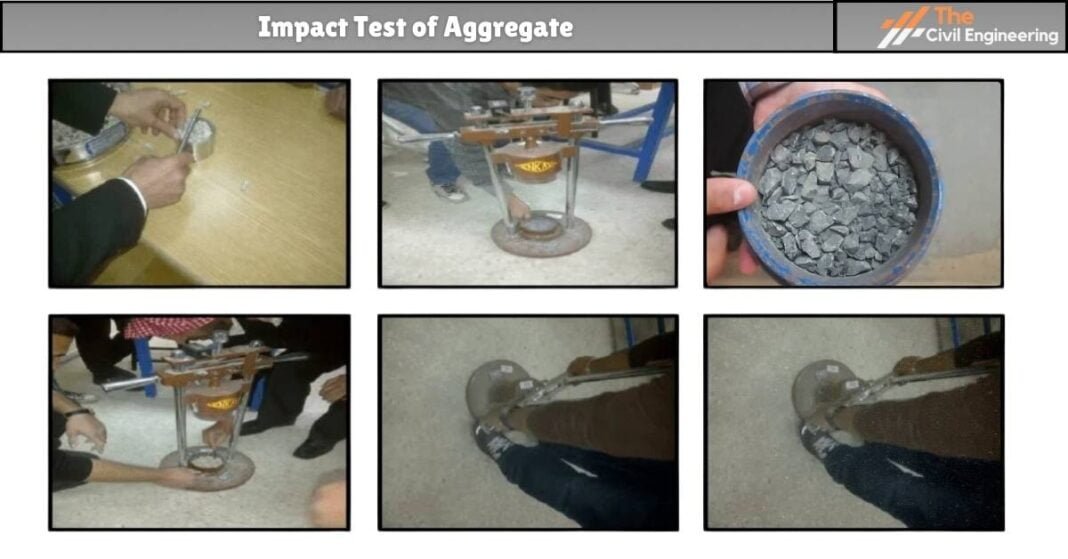1. Introduction
Highway pavements are an essential component of transportation systems providing access and establishing linkages from one corner to another throughout the world. Due to its utmost importance, there has been a need to construct highways that are structurally sound as well as facilitate the easy and comfortable movement of goods and people. The stability and quality of roads are thus checked by carrying out several tests. One such test is the impact test.
The impact test is a type of quality control test for highway pavements and is used to check the suitability of aggregates to be used in the construction of highway pavements.
The property by which the aggregates are capable of resisting the impact is known as toughness.
The road aggregates are subjected to subsequent impact due to the movement of vehicles.
Hence, the road aggregates should possess sufficient toughness to withstand such an impact.
The impact value test is hence used to determine the measure of the toughness of aggregates.
2. General Test Procedure of Impact Test of Aggregate
The general test procedure of the aggregate impact value test is briefly described below:
Objectives of Impact Test
1. To assess the suitability of the aggregate to be used in the highway pavement.
2. To determine the aggregate impact value.
Apparatus Required
1. An impact testing machine weighing between 45kgs to 60 kgs with a metal base.
2. A cylindrical steel cup having an internal diameter of 102mm, depth of 50mm, and thickness of 6.3mm.
3. A metal hammer with the cylindrical lower end and weighing 13.5 to 14kgs.
4. A cylindrical metallic measure with 75mm internal diameter and 50mm depth.
5. A weighing balance with a capacity not less than 500g.
6. A tamping rod of 10mm diameter and 230mm long.
Procedure of Impact Test
The procedure of the impact value test includes the following series of steps:

1. The aggregate samples of size 10mm to 12.5mm (passing through 12.5mm sieve and retained on 10mm sieve) are first taken and oven-dried at a temperature ranging from 100 degrees Celsius to 110 degrees Celsius for about four hours.
2. The aggregates are then allowed to cool down at room temperature.
3. Then, the aggregates are poured into the measuring cylinder such that 1/3rd of the cylinder is filled.
4. The aggregates are duly compacted by about 25 blows of the rounded end of the tamping rod.
5. Similarly, two such layers of aggregates are filled in the cylinder and compacted.
6. Then, the net weight of the aggregates is determined.
7. The experimental setup of the impact value testing apparatus is then done.
8. The cup is then firmly fixed on the base of the testing machine followed by the placing of the test sample.
9. The specimen is further compacted by giving about 25 blows of the tamping rod.
10. Then, the hammer of the testing machine is raised until the lower face is approximately 380mm above the specimen and then it is allowed to fall freely on the specimen.
11. Fifteen such blows of the hammer are then given. It must be noted that the interval between the successive blows is not more than one second.
12. The crushed aggregate is then passed through a 2.36mm IS sieve then the fraction passing through the sieve is weighed.
Observations & Calculations
| Observations | Sample 1 | Sample 2 |
| Total weight of the dry sample (W1 gm) | ||
| Weight of portion passing 2.36 mm sieve (W2 gm) | ||
| Aggregate Impact Value (percent) = W2 / W1 X 100 |
Mean =
Result
Aggregate Impact Value =
Recommended Values for Impact Test of Aggregate
Classification of aggregates using Aggregate Impact Value is as given below:
| Aggregate Impact Value | Classification |
| <20% | Exceptionally Strong |
| 10 – 20% | Strong |
| 20-30% | Satisfactory for road surfacing |
| >35% | Weak for road surfacing |
Specified limits of percent aggregate impact value for different types of road construction by the Indian Roads Congress are given below.
| Sl No | Type of pavement | Aggregate impact value, not more than |
| 1. | Wearing Course | 30 |
| a) | Bituminous surface dressing | |
| b) | Penetration macadam | |
| c) | Bituminous carpet concrete | |
| d) | Cement concrete | |
| 2. | Bitumen bound macadam base course | 35 |
| 3. | WBM base course with bitumen surfacing | 40 |
| 4 | Cement concrete base course | 45 |
| Read More: Difference Between Tension and Compression Force |
| Read More: Essential Guide: Top Difference between 33, 43 and 53 Grade Cement |

